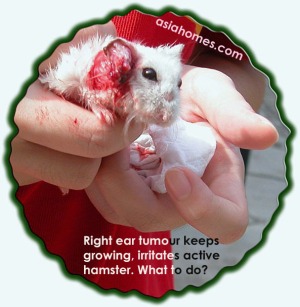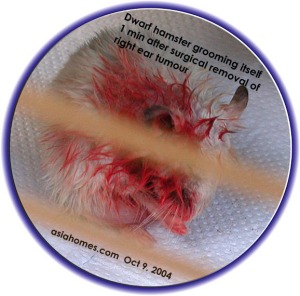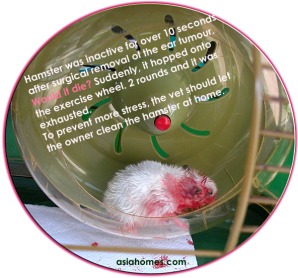|
Health - Older hamsters
The heavy-eared
dwarf hamster
 To
operate under general anaesthesia or not? What should the
vet do with the dwarf hamster who could no longer bear the heavy
burden of a large ear tumour? The young lady owner could
not bear to see its quality of life deteriorate daily. To
operate under general anaesthesia or not? What should the
vet do with the dwarf hamster who could no longer bear the heavy
burden of a large ear tumour? The young lady owner could
not bear to see its quality of life deteriorate daily.
The 2-year-old dwarf hamster was active. I could see its dry
faecal droppings every few minutes. Its cheek pouches were
filled with food puffing up its face. It was healthy and had a
voracious appetite.
The ear tumour had grown much bigger. More than 10 mm X 4 mm. It
was covered by a dark brown dead layer of cells. I pulled
on the tumour to check whether it had a stalk. Instead the dead
covering of cells peeled off. It had a small short stalk.
Now, the tumour was a raw mass of
pinkish cells mixed with some pus. It was irritating the hamster.
It kept
scratching it. Trying to get rid of it.
The young lady owner had checked out the internet for more
information on how to treat this problem. Nowadays, the
internet had educated many pet owners and anybody who cared to
search for information.
What should the veterinary surgeon do to handle this case?
To operate under general anaesthesia so that the hamster would
not feel the pain of surgery. And perhaps die. If no
anaesthesia, it would have a higher probability of survival but
might die under the stress of handling and operating.
What should
the vet do? If the hamster dies on the operating table, it
would be too emotional for everyone. It could be disastrous for
the reputation of the vet. Death of a beloved pet or
family member does not permit excuses. No explanation or apologies
would be acceptable. Yet, the veterinary surgeon is no
God.

This white dwarf hamster was an active ball of dynamite. It
might not die under anaesthesia. Yet,
nobody could guarantee that such a small animal would be
able to survive the anaesthetic or die after anaesthesia.
Obviously, no owner would give the veterinarian a second
chance if the first patient had died on the operating
table.
So, what should the vet decide? If there was no
anaesthesia, would the hamster die of fright and stress
during handling? It had to be handled firmly for the tumour to
be excised. The handling and the surgery could
just lead to shock and death.
Vets don't want deaths. The owner does not expect
an active hamster to die on the operating table.
So, what should the vet do?
One decision may be to
refer to a more experienced veterinary
surgeon. To preserve a hard-earned
reputation.
The other solution was to perform a speedy operation without
anaesthesia. Less than 5 seconds. Locate the base of the
ear tumour, snip it away from the skin of the ear. Stop
the bleeding. This was done in this case.
The hamster was motion-less
after the surgery. It was sitting on its chest.
Would it keel over and die?
It was breathing fast. Would the tiny heart fail
now? |
It
was not
moving for the next few seconds. Was it in a state of
shock? Stressed out.
The lady owner waited.
Her mum waited. I hoped for the best. The bleeding
had stopped after I had pressed a piece of tissue
against the wound. But not before baptising the
hamster's head with red liquid.
I held my breadth. Wake up, I willed the hamster.
It got up, as if from a deep sleep. It put its
paws into its mouth and started to wipe the blood off
its face. It was the most beautiful experience of
life that money could not buy.
Unexpectedly, it hopped onto the exercise wheel and did
two rounds. "Take the hamster off," I asked
the lady owner.
In any case, it laid down on the green wheel, totally exhausted.
Vets would normally proceed to clean off the blood and
hand a clean hamster to the owner.
This would be a mistake as the hamster would be further
stressed.
In this case, the owner took the hamster
home in a taxi. She lived quite far away. I am
sure she would slowly but lovingly cleaned it up
using warm water on cotton balls.
The hamster would be comforted by the
smell of the owner's hands. There would be much less
stress. And a much higher probability of
surviving.  |
|
 This educational article
is sponsored by asiahomes.com,
"affordable homes for expatriates". Pictures are ©
toapayohvets.com. Last
updated: 10 Oct 2004
This educational article
is sponsored by asiahomes.com,
"affordable homes for expatriates". Pictures are ©
toapayohvets.com. Last
updated: 10 Oct 2004
|